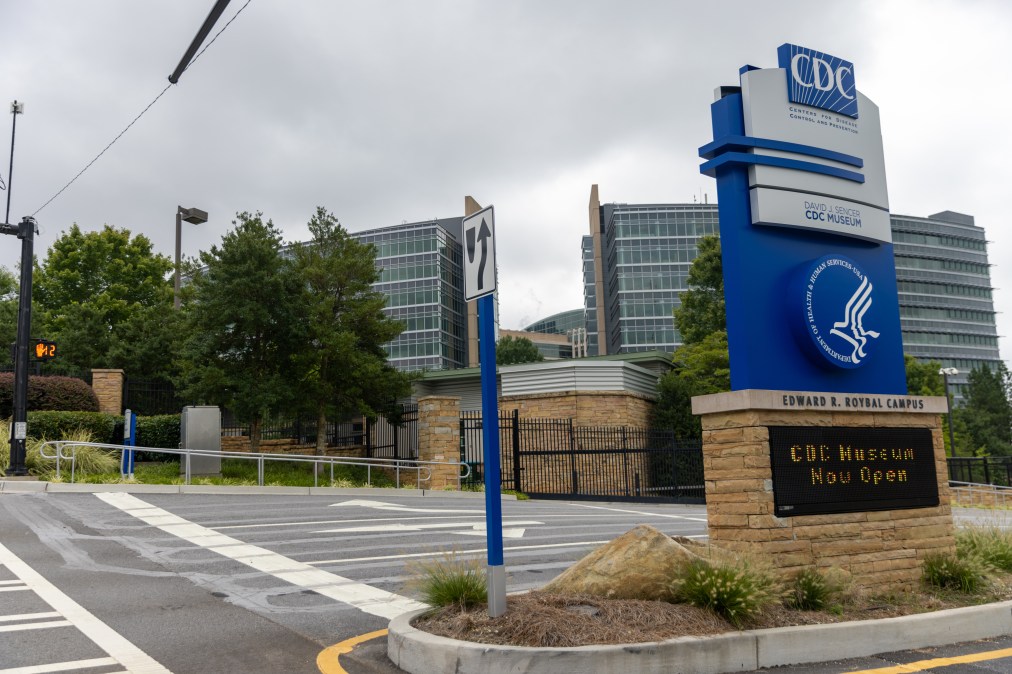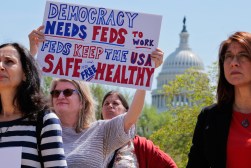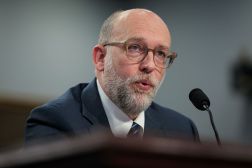CDC sent RIF notices, then pulled some back. The result is chaos, advocates and workers say

Current and former Centers for Disease Control and Prevention employees and their advocates painted a bleak picture of the public health agency Tuesday after the Trump administration’s most recent reduction-in-force efforts, warning of adverse impacts on public health.
In two separate virtual press conferences, those workers and advocates said they’re concerned about the implications of cutting workers from the agency, including staff reductions to its public health data functions, human resources team, library staff, and Washington office, which is responsible for briefing lawmakers.
“At this point in time, a quarter of CDC is gone,” said Abby Tighe, a founding member of the National Public Health Coalition and a former CDC worker. “There are very few people left in leadership at the agency. We know that at the highest levels of leadership in the CDC, there are no public health or medical professionals left to help guide CDC recommendations.”
Making things more difficult is a lack of information about exactly who is on their way out.
After more than 1,000 CDC workers were sent RIF notices last week amid mass layoffs the White House blames on the shutdown, the agency reversed its decision for nearly half of those individuals, leaving roughly 600 workers still without a job, according to estimates shared on those calls by representatives from NPHC (formerly known as Fired But Fighting) and American Federation for Government Employees. Those representatives noted that their estimates were being pieced together and are not coming from formal or official sources.
Aryn Melton Backus, a CDC employee working in the Office of Smoking and Health who spoke on the NPHC call, said the administration has attempted to fire her three times, with one of those overturned amid court battles and the most recent attempt from last week ultimately getting withdrawn. Backus said she’s currently on administrative leave and wants to go back to her job, but her future at the agency is unclear.
“My situation just highlights the chaos and confusion that federal employees have experienced over the past year,” Backus said. “I’m stuck in limbo, following court cases, gathering information, trying to figure out what my next step should be.”
She added later: “At this point, it seems like the chaos and lack of transparency is the point.”
The administrative disorder has been a theme with many of the Trump administration’s efforts to reduce the size of the federal workforce. In addition to previous instances in which the administration had fired and then recalled workers, RIF’d employees have also said they’re getting erroneous communications from their former agencies.
Workers at the Food and Drug Administration, for example, recently received their colleagues’ sensitive information, including Social Security numbers, in mailed RIF packets. State Department workers who were previously RIF’d mistakenly received furlough information — a problem that two sources told FedScoop is still persisting despite the agency saying it was addressing the “data” error that caused the problem. And Federal News Network also reported similar issues with previously RIF’d workers still getting agency emails at the General Services Administration.
In response to an inquiry from FedScoop about the CDC workers impacted and reasons for pulling back some RIFs, a spokesperson for the Department of Health and Human Services reiterated an earlier statement about the decision. They also added that employees who received incorrect notices have all been notified they will not be RIF’d. An HHS official previously told CNN the issue had been a coding error.
A legal filing late Tuesday offered some insight, though not specifically for CDC. According to a declaration by Thomas Nagy, HHS’s chief human capital officer, the department accidentally sent 1,760 RIF notices to employees at HHS when it meant to send them to 982 workers. That declaration, however, does not specify how many of those were at CDC.
Those familiar with the government space pointed to a lack of human resources functions to handle those issues as a possible reason for the errors.
Jenny Mattingley, vice president of government affairs at the Partnership for Public Service, told FedScoop the organization was aware of fired workers getting recalled or receiving incorrect RIF notices both in the most recent round of actions and previously.
“This points to both a lack of HR capacity to manage these complex actions as well as a lack of understanding by political leadership about the critical programs federal employee[s] run and the consequences of haphazardly cutting staff,” Mattingley said. “This not only causes chaos for agencies and employees but directly impacts services that people and businesses across the country rely on.”
William Resh, a department chair and professor of public management and policy at Georgia State University, said “the one consistency that this administration has had in terms of human resource management has been utter inconsistency.”
While much has been discussed about various losses in capacity across the government, one element that hasn’t been talked about as much is the losses to human resource functions, Resh said. The Office of Personnel Management has lost capacity and HR positions within agencies have also been impacted by the cuts under the Trump administration, he said.
Resh added that it’s hard for the administration to make accusations that workers are redundant, non-essential, or not carrying out its priorities when it doesn’t appear to have a transparent “accounting of exactly who is in what position and what they’re doing.”
Notably, the CDC’s own Office of Human Resources faced cuts in the RIF last week, per speakers on both the public health coalition and union calls. On the AFGE call, one anonymous speaker who said they worked at the CDC’s human resources office and was RIF’d in April said that nearly 90% of the office was eliminated in the latest RIF.
“While CDC is recognized as a premier scientific agency, its success depends on the people who make that science possible,” the anonymous worker said. “Without HR, there is no workforce to conduct the research, respond to outbreaks, or sustain operations.”
FedScoop asked HHS about cuts to the HR office specifically, but the spokesperson’s response did not address that question.
On the NPHC call, Karen Remley, who previously ran the agency’s National Center on Birth Defects and Developmental Disabilities, called on Congress to demand information about people who were RIF’d and the agency’s reasoning.
“We don’t even really know what the real numbers are because we don’t have that open, transparent conversation about how to make sure that our public health work in our country is the very best it can be, and that we continue to improve,” Remley said.






